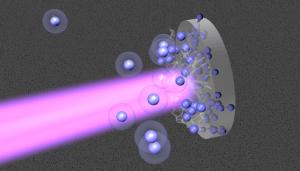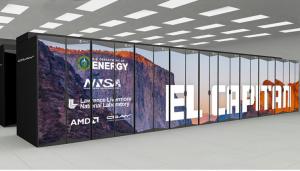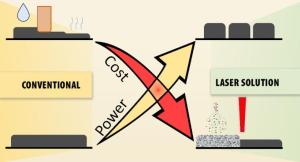LAB REPORT
Science and Technology Making Headlines
July 1, 2022


Laser-driven shock waves reaching several million atmospheres break the extremely strong triple-bond of nitrogen molecules and free up a fraction of the L-shell electrons of the dissociated atoms. Credit: Liam Krauss/LLNL
Breaking the bonds
Lawrence Livermore scientists recently obtained high-precision thermodynamic data on warm dense nitrogen at extreme conditions that could lead to a better understanding of the interiors of celestial objects like white dwarfs and exoplanets.
The team, which includes researchers from the University of California, Berkeley, and the University of Rochester, used an advanced technique that combines pre-compression in a diamond anvil cell and laser-driven shock compression at the Omega Laser Facility at the University of Rochester.
Molecules of nitrogen (N2) make up 78% of the air we breathe. They are unique because the two nitrogen atoms in N2 are bound with a triple covalent bond, which is the strongest of all simple diatomic molecules. Nitrogen also is an important constituent of celestial bodies in the outer solar system and beyond. For example, ammonia (NH3) storms are believed to exist in giant planets like Jupiter, while the dwarf planet Pluto, Saturn’s icy moon Titan and Neptune’s icy moon Triton have N2-rich atmospheres.
“It is very exciting that we can use shock waves to break these molecules and understand how pressure and density induce changes in chemical bonding,” LLNL physicist Yong-Jae Kim said. “Studying how to break nitrogen molecules and how to free up electrons is a great test for the most advanced computer simulations and theoretical modeling.”


El Capitan will go online in 2023.
Going mainstream
In March 2020, when Lawrence Livermore National Laboratory announced the exascale “El Capitan” supercomputer contract had been awarded to system builder Hewlett Packard Enterprise, which also was kicking in its “Rosetta” Slingshot 11 interconnect and which was tapping future CPU and GPU compute engines from AMD, the HPC center was very clear that it would be using off-the-shelf, commodity parts from AMD, not custom compute engines.
This stood somewhat in contrast to its peer HPC center, Oak Ridge National Laboratory, whose “Frontier” exascale supercomputer has custom “Trento” Epyc 7003 processors with Zen 3 cores and the Infinity Fabric 3.0 interconnect, which provides coherent memory between the Trento CPUs and the “Aldebaran” Instinct MI250X GPU accelerators.
Being installed later means that Lawrence Livermore can intersect the AMD compute roadmaps further into the future, and get more powerful compute engines to reach its “greater than 2 exaflops” peak performance target. And while AMD was saying more than two years ago that El Capitan was going to be based on standard “Genoa” Epyc 7004 parts and standard “Radeon Instinct” GPU parts — AMD had not yet dropped the “Radeon” brand from its datacenter motors when it was speaking — it was not at all obvious, even weeks ago that El Capitan would not be using discrete Epyc and Instinct chips to do its work.


Compared with conventional slurry-based film electrode manufacturing methods, dry laser powder bed fusion is promising in generating structured electrodes for high power, low cost lithium ion batteries. Image by Jianchao Ye/LLNL.
Charging up Li-ion batteries
The next generations of lithium-ion batteries require higher energy and power densities at a lower cost. Current battery manufacturing, based on slurry casting and coating, is struggling to further improve these key metrics.
Lawrence Livermore National Laboratory (LLNL) is partnering with Ampcera Inc. to develop solvent-free Laser Powder Bed Fusion (L-PBF) additive manufacturing technologies for the fabrication of 3D-structured lithium battery cathodes.The project received $1.5 million from the Advanced Manufacturing Office at the U.S. Department of Energy.
L-PBF was originally developed for 3D printing of metal parts. LLNL's Jianchao Ye, staff scientist and the lead principal investigator of the project, is planning to use this additive manufacturing technology to thermally bind the cathode powder mixtures onto the aluminum current collector and generate unique 3D structures for faster charging and higher-energy-density batteries.
“The environmentally benign process allows for thick high-capacity 3D cathode structures to be processed, enabling lithium-ion batteries to reach the fast-charging goal of 80% charge in 15 minutes or less,” Ye said.


LLNL Report takes a break
The LLNL Report will take a break for the Fourth of July holiday. It will return July 15.





